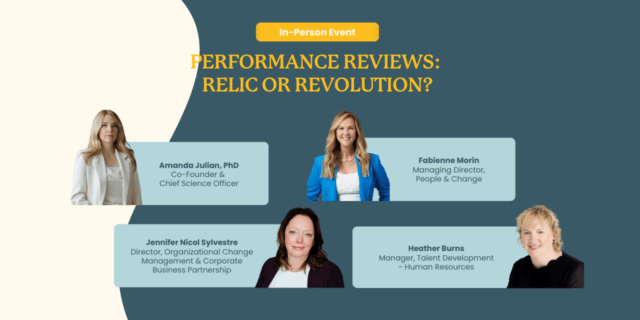
Learning vs. Developing: Getting at What Moves The Needle

Let’s be clear – leadership development and organizational change is not easy work. Development is often non-linear, doesn’t always produce clearly visible results, and frequently unfolds over a substantial period of time (as opposed to in single moments). Author and leadership coach Marshall Goldsmith identifies a key challenge (or barrier), often derailing development: “Many leadership programs are based on the faulty assumption, that if we show people what to do, they can automatically do it.” Pfeffer and Sutton’s Knowing-Doing Gap shows how incorrect this assumption is, indicating that knowing “what” good leadership looks like and being able to put it into practice are two different things, i.e., talking about something doesn’t equate to competence. The Stanford researchers note that the gap between saying we’ll do something and actually doing so often persists because talk and action tend to be equated with one another. Whereas talk can be assessed immediately in terms of quantity and quality, the ability to get things done (or to “walk the talk”) requires a more extended timeframe and more robust measurement. What this means is that while learning is vital to leadership development, if we stop at the point of providing information and simply checking completion rates, we may end up targeting knowledge acquisition without affecting critical behavior change, ultimately hindering leaders’ potential to develop while mistakenly thinking we’ve done our part.
The field has arrived at a critical point in which the trajectory of traditional leadership development programs must change due to both what we’ve learned and organizations and leaders demanding advanced and customized solutions that provide tangible value. The good news is there is clear evidence that leadership development is possible and can have lasting results when there is a direct focus on skills, behaviors, and competencies. The most current research confirms our view that the focus needs to shift to teaching high-potential and emerging leaders how to develop and to consider all the factors surrounding their development so that they have the tools to transfer learning into real-world performance. This is in contrast to “one-size fits all” approaches, which, while scalable, can gloss over important contextual factors unique to the organization that are critical to leader development and success, and often lack long-term evidence of growth or transformation.
In 2017, MIT wrote about “Leadership Development’s Epic Fail,” noting that “most programs have a critical weakness – they view leaders as sets of competencies, not individuals,” ultimately ignoring important idiosyncrasies of both leaders and organizations. What’s worse is that there is little evidence that many of these programs work; Kellerman from Harvard and Pfeffer from Stanford note that “the development market is filled with fads – slick behavioural models and fun, engaging tools – that don’t really move the needle.” This paradigm takes the view that all leaders have to do to succeed is perform at the top in a generalized competency model, which, while important, ignores the scientific discipline around individualization and contextualization (e.g., subordinate perceptions, relationship to organizational outcomes, or self-awareness). McNulty from MIT, Petrie from the Center for Creative Leadership, and many others note that there are two major drivers affecting the pace of change in the field of leadership:
- The increased complexity of the environment in which leaders must lead (notably but not exclusively, information overload, the dissolving of traditional organizational boundaries, increased globalization, and new technologies and innovations such as AI).
- Our increased understanding of how humans think and act, which psychology and neuroscience advancements, along with behavioral economics and analytics, have driven. The “Great Man” theory – brought forward by Thomas Carlyle – assumed that people needed to change to emulate a leadership prototype, but we now know there are multiple types of behaviors and skills displayed and utilized by successful leaders. Performance is complex, much like great athletes don’t always make the best coaches: “Any approach that tries to reduce the complexities of leadership to a series of standard boxes to be ticked or traits to be emulated will have little enduring impact.“
Leading With a Compass, Not a Map
At Monark, our research and experiences with leaders in assessment, learning, and development have helped shape our view that leaders are complex, multi-faceted individuals, and their behaviors and development all occur within a context. The context of ever-changing circumstances (be it the people or environment) means that we can’t rely on a single leadership “blueprint” – we need to reimagine how people learn and what drives lasting change. In a sense, we need to focus on teaching leaders not just how to continuously learn but also how to constantly apply what they are learning and adapt to changing circumstances. Our research has led us to distill leadership development into two key principles that, when designing programs and interventions, will actually “move the needle”:
- Great programs will support contextualized leadership development, teaching leaders how to adapt, evolve, and handle ambiguity in their organizations. At Monark, we believe in a hybrid approach to development – our learning and development efforts start with a general competency model that is always linked to an organization and its unique leadership culture/needs. Our Live Mastery Sessions also allow cohorts to digest learnings and discuss particular organizational application concerns or questions, learning from each other and our certified coaches and IO psychologists. (For more on developing skills to adapt and handle continuous change, see our learning courses: Navigating Challenges, Fostering Innovation and Driving Change, Captain in the Storm: Guiding Teams Through Challenges, and Strategic Thinking).
- Lasting, transformative leadership change will be grounded in individual leaders’ strategic self-awareness and continuously enabled by self-accountability and evidence-based change processes (e.g., goal-setting theory). Leaders will need to take a hands-on approach to their development, integrating their own values and principles and actively experimenting with evidence-based behaviors that lead to stronger performance. Monark ensures all these boxes are checked by not simply offering learning courses but instead embedding them within a larger holistic application. It provides targeted micro-360s and real-time AI-generated feedback, supplying leaders with the self-awareness necessary to leverage strengths and focus on areas of improvement while moving through learnings. Our Super Leader dashboard provides accountability by rating leaders based on not just their learning progression but also their actual skill growth and essential outcomes for the teams they lead. Finally, our Leader Relationship Management tool enables leadership change by making it easier to put learning into action.

